The Everglades
Florida Aqua: Artistic Reflections on Water
A Digital Exhibition
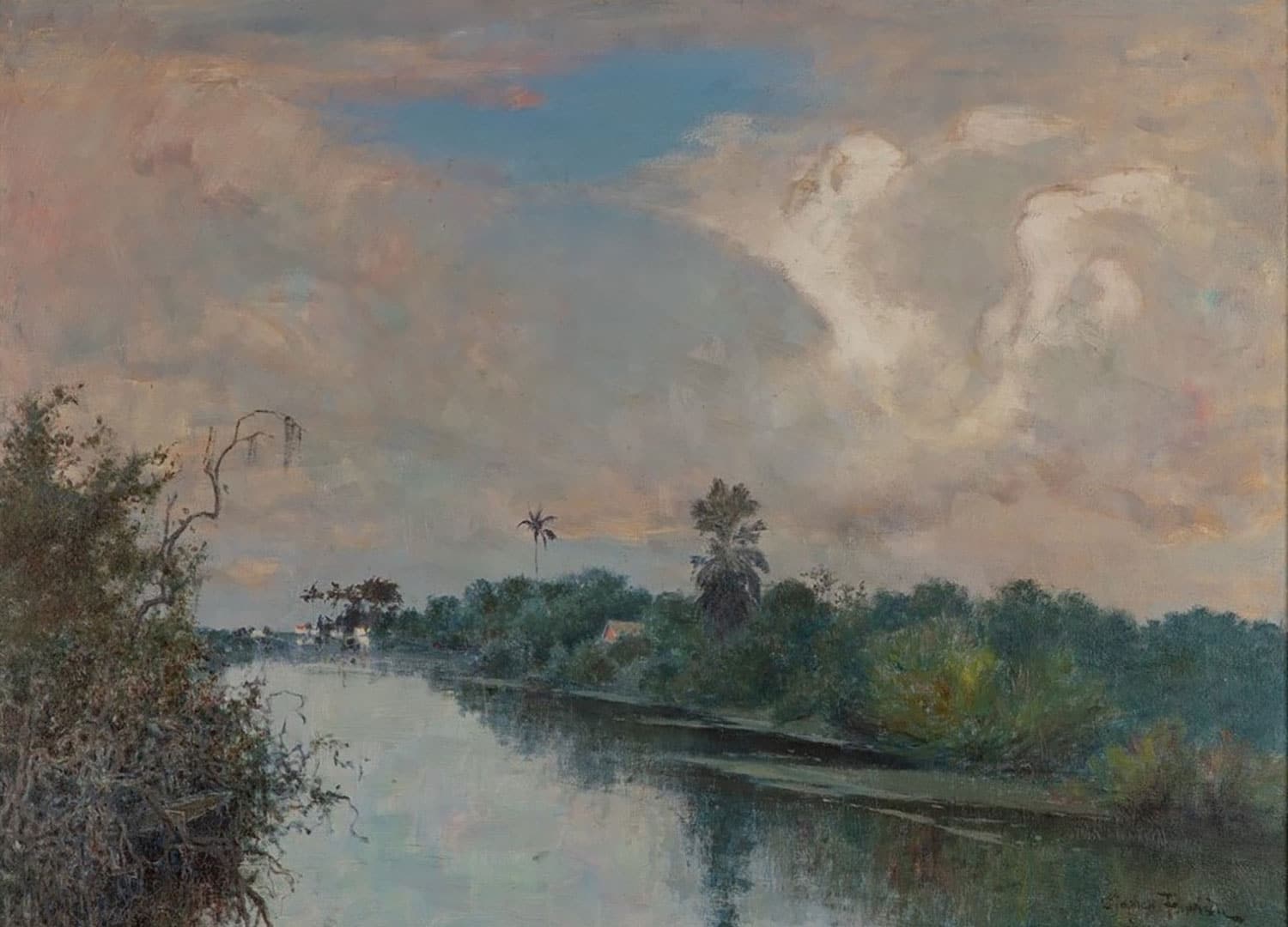
Introduction
The Everglades is a tropical wetland in South Florida. The water system of the Everglades begins near Orlando with the Kissimmee River which flows to Lake Okeechobee. During the wet season, water from Lake Okeechobee flows to the south as a slow-moving river across wetlands toward Florida Bay at the southern end of the State. The Everglades comprises various ecosystems, including sawgrass marshes and cypress swamps, which contain abundant species such as cypress, flamingo, and alligator. This water system and the rich flora and fauna system of the Everglades nourished the life of the Seminoles, a Native American people who have been living in the Everglades since the eighteenth century. The Seminole were a heterogeneous people made up of mostly Muscogee Creeks from Georgia who settled in Florida to escape conflicts and encroachment on their land. Using dugout canoes made from hollowed trees, Seminole people went hunting and fishing in the swamp to support their way of life. Artists like George de Forest Brush depicted hunting scenes of idealized Native American figures as a metaphor for an idealized and non-urbanized world away from the fierce industrialization of American society in the nineteenth century. However, urbanization impacted the Everglades in the late nineteenth to early twentieth centuries. The development of the city of Miami, construction of Henry Flagler’s Florida East Coast Railroad, the Tamiami Trail, and tourism had a negative impact on Seminole people’s lives. Since the late nineteenth century, most Seminole families moved away from the Everglades. Today, Seminoles living in the Everglades support themselves largely through agriculture, cattle, and the tourism industry.
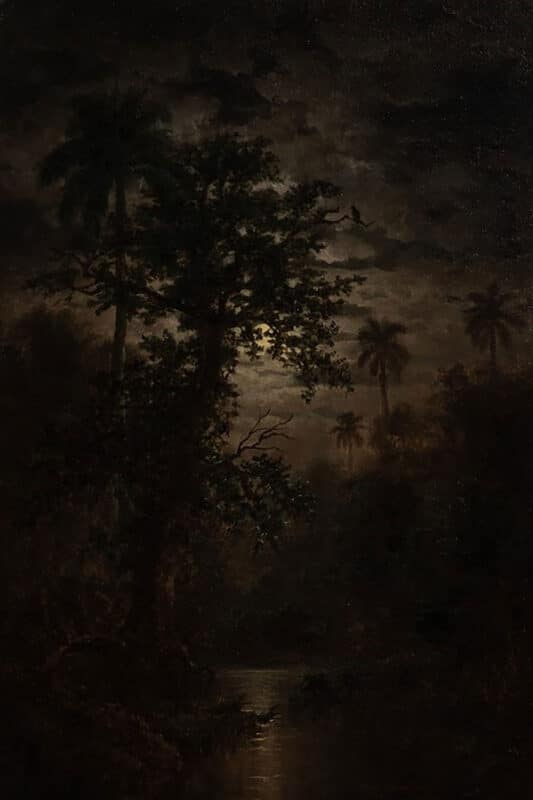
Moonlight In The Everglades
Esteban Chartrand
Born into a wealthy family of French-origin in Limonar, Cuba, Esteban Chartrand visited France in 1854 and again in 1864 to study painting. In Paris, he studied landscape painting under one of the leading figures of the French Barbizon School, Théodore Rousseau, who encouraged Chartrand to seek inspiration from nature. In this painting, Chartrand documented the Everglades in the moonlight. The scene is bathed in a bright sliver luster from the moon emerging from behind the tree in the center of the painting. The moonlight dims at the edges of the painting, which resembles the vignette-like effect of early photography.
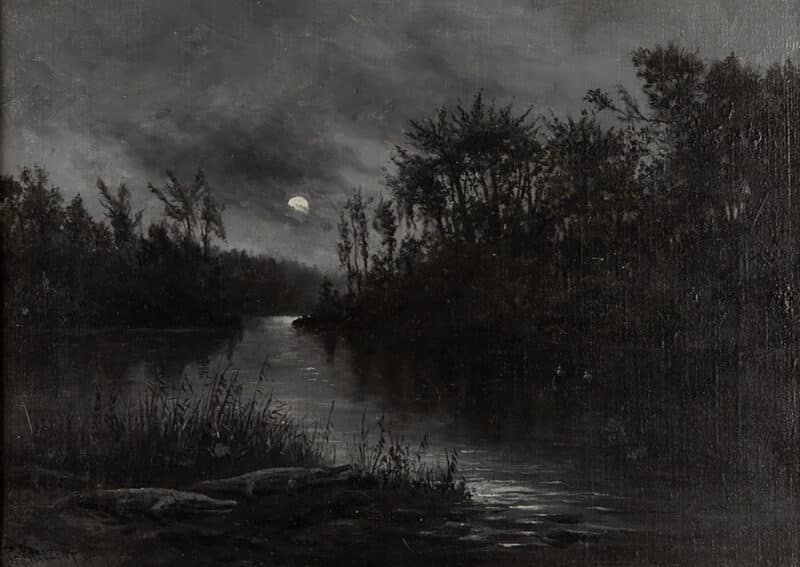
Moonlight on the Everglades
Paul Frenzeny
Born in France, Paul Frenzeny immigrated to the United States in the 1860s. After becoming an artist-correspondent for Harper’s Weekly in 1868, he traveled on horseback on a lengthy tour across the country to produce sketches and illustrations focusing on western life in America. This painting depicts an alligator hunting scene under the moonlit sky in the Everglades. Here, the moon shines its silver light on the calm water of the jungle. The alligators, hiding in the dim night, rest on the shoal. For the Seminoles, hunting alligators was essential for survival and provided food for the family.
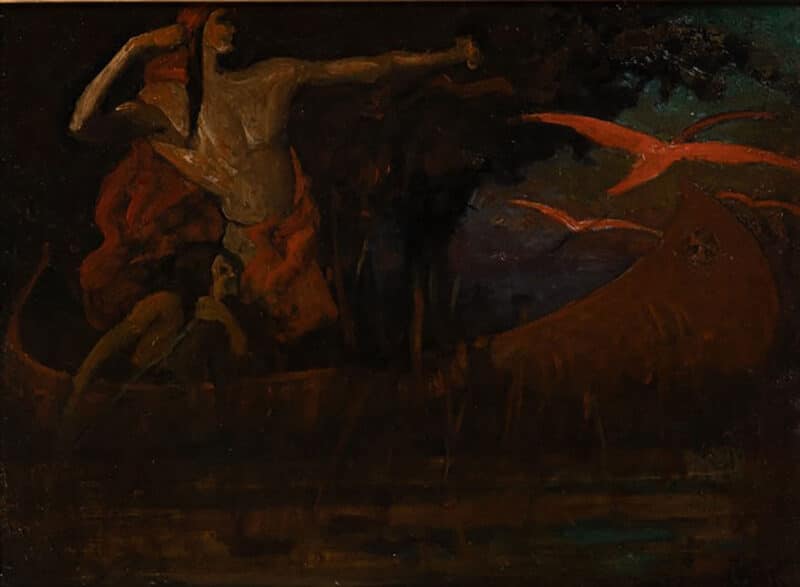
Hunting Flamingos
George de Forest Brush
George de Forest Brush was born in Shelbyville, Tennessee and trained as an artist in Paris. Brush was renowned for his idealized paintings of Native American figures situated in a beautiful, pre-industrial world undisturbed by the rising chaos of industrialization and mechanization in contemporary American society. In this small painting, Brush depicted a dramatic scene with dynamic brushstrokes and color: a semi-nude Seminole man stands on a canoe navigated by a Seminole woman. He stretches his arms to aim at the bright red flamingos rising from the swamp. A swath of red cloth partly covers his idealized body characterized by broad shoulders, slender waist, solid muscle, and tan skin.
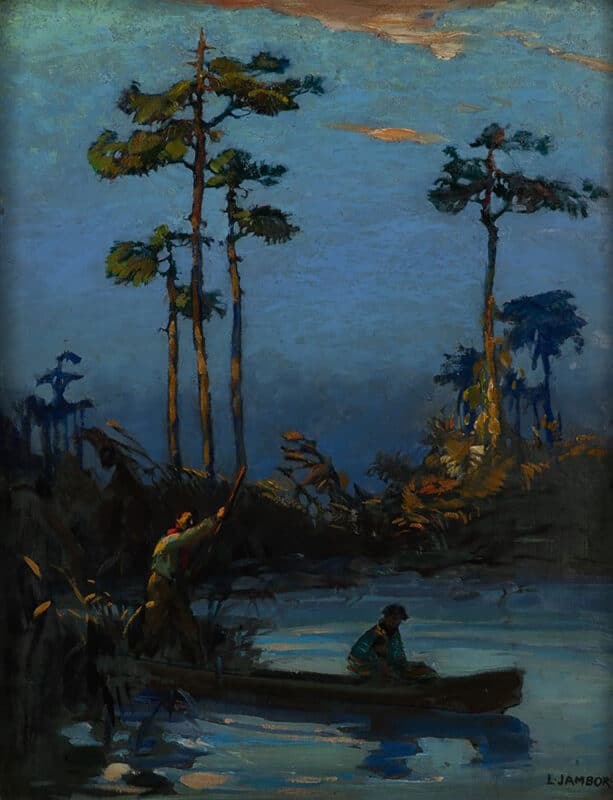
Seminoles in Canoe
Louis Jambor
Born in Hungary, Louis Jambor studied at the Hungarian Royal National School of Arts in Budapest. After he immigrated to the United States in 1923, he painted murals for churches and city halls throughout the country. In this piece, Jambor depicted a Seminole man and woman poling their dugout on the waters of the Everglades. Both figures wear traditional late-nineteenth-century patchwork garb. A warm orange light emphasizes the plants in the center and background. The trees indicate the possible material of the dugout—cypress—the most flood-tolerant tree species in Florida. Cypress trees can adapt to the water-logged soil of the Everglades because of their unique root system.
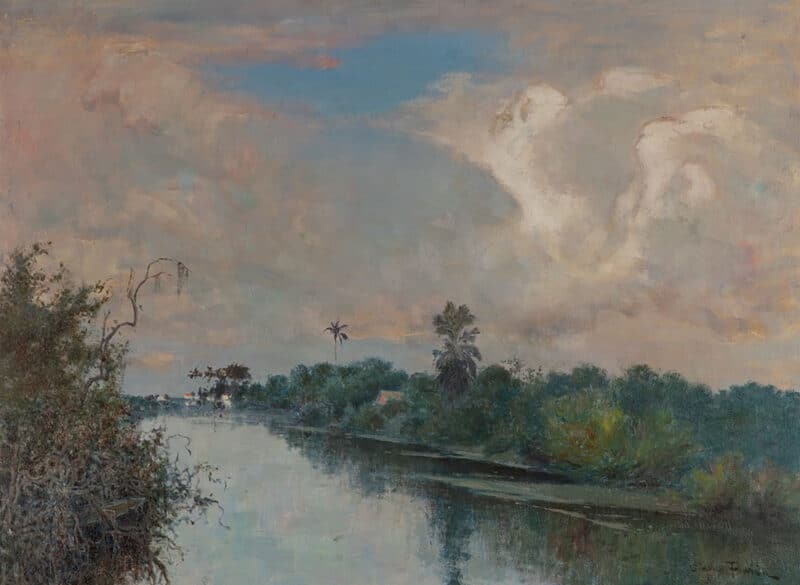
On the Miami River
Stephen Maxfield Parrish
Born in Windsor, Vermont, Stephen Maxfield Parrish was considered one of America’s leading etchers of the late nineteenth century. He was also active as a painter yet, in the mid-1920s, he suffered a stroke which made it difficult for him to practice as an artist. In this painting, Parrish used visible brushstrokes and little touches of color to render the rising humidity on the Miami River. Carrying fresh water from the Everglades to Biscayne Bay, the Miami River was essential to the way of life of the Seminole People who remained in the Everglades following the Seminole Wars (1816-1858).

Tamimiami Trail
George Pearse Ennis
Born in St. Louis and trained at several art schools, George Pearse Ennis pursued his career as a painter and a teacher. Best known for his watercolors, Ennis rendered landscapes and seascapes with strong color. In this scene, four African American men mow grass in the swamp with scythes. Ennis used blotches of highly saturated blues and greens to articulate the water and the plants surrounding them. People perceived the Tamiami Trail as an engineering feat when it first opened in 1928 because it connected Florida’s west and east coasts, from Tampa to Miami. However, crossing the Everglades from its northern border to Miami City, Tamiami Trail, and the Tamiami Canal, blocked the flow of water from Lake Okeechobee to Florida Bay, which caused harmful effects on the ecosystem in the Everglades.
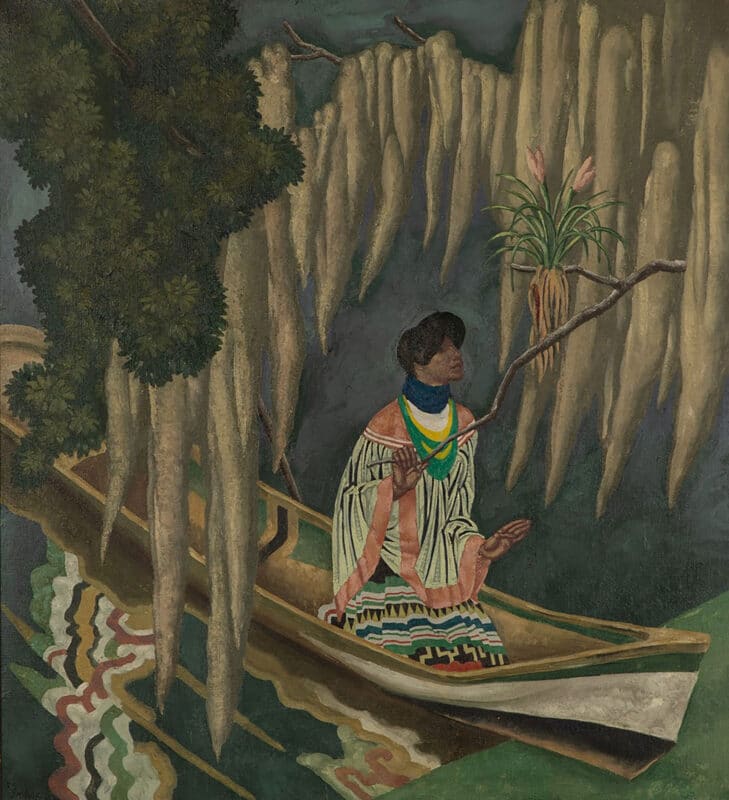
Seminole Indian in a Dugout
Eugene Francis Savage
Eugene Francis Savage trained in the academic tradition in Rome, where he studied ancient and Italian art. Savage participated in mural projects at various public institutions throughout the United States. Seminole Indian life and culture captured Savage’s interest during his first trip to South Florida swampland in January 1935. Through his close interaction with the Seminole people in the Everglades, Savage noticed the negative impact of urbanization on their lives: between 1900 and the 1920s, draining the Everglades in order to connect railroads and opening up the Everglades for tourists caused many Seminole people to lose their camps. Many resorted to performing alligator wrestling and selling craftwork to tourists for their livelihood. In this tranquil and mysterious scene, the water and vegetation of the swamp embrace the Seminole woman and her dugout canoe while she enjoys the aroma of the orchid branch in her hand.
